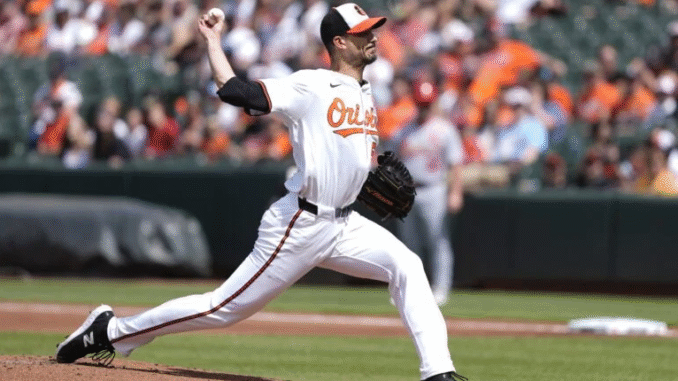
https://twitter.com/JustBB_Media/status/1926381913050128749?ref_src=twsrc%5Etfw%7Ctwcamp%5Etweetembed%7Ctwterm%5E1926381913050128749%7Ctwgr%5Ed0f419c4b520c4fafb00cf23e3da25fb1efedf65%7Ctwcon%5Es1_&ref_url=https%3A%2F%2Flastwordonsports.com%2Fbaseball%2F2025%2F05%2F26%2Forioles-pitching-rotation-depth-problems%2F
Firstly, 41-year-old Charlie Morton has been nothing short of disastrous for the Orioles. In six starts, the veteran right-hander sports an ugly 7.68 ERA and a bloated 1.756 WHIP. His walk rate has soared to five per nine innings, and he’s allowing two home runs per nine.
Morton’s decline has been noticeable in recent seasons. Between 2022 and 2024, his walk rate hovered above three, and his home run rate was between 0.8 and 1.5. His strikeouts fell from 10.7 per nine in 2022 to 9.1 in 2024. Still, few could have predicted his dramatic collapse this year.
Kyle Gibson, who last pitched for the Orioles in 2023, has fared even worse. Over four starts, he’s posted a dismal 16.78 ERA in 12 1/3 innings, along with a 2.919 WHIP. It was bad enough for the Orioles to cut him loose on May 18.
Tomoyuki Sugano, the third of the team’s major rotation additions, has thankfully been a bright spot. In his first 10 starts, the 35-year-old Japanese right-hander has posted a solid 3.07 ERA and a 1.023 WHIP. While his strikeout total (32 in 58 2/3 innings) is modest, he’s walked just 10 batters, making him easily the rotation’s best performer so far.
Beyond these three, other starters like Dean Kremer, Cade Povich, and Zach Eflin have ERAs above 4.50 and high home run rates. None of them strike out more than nine batters per nine innings; Kremer and Eflin sit at 6.5 and 4.9, respectively, while Povich has allowed more hits than innings pitched, not counting walks.
The rotation isn’t suffering from inconsistency—it’s plagued by persistent struggles. Besides Sugano, each starter has their own significant issues, making fixes even harder. This doesn’t even take into account injuries to Grayson Rodriguez and Kyle Bradish.
Bullpen
The Orioles’ bullpen isn’t all doom and gloom. A few bright spots have emerged in late-game situations, though consistency is still a major problem.
The biggest surprise has been Bryan Baker. His ERA has plummeted from five in 2024 to 1.93 in 2025, and he’s sporting a 0.857 WHIP. His walk rate is down, while his strikeouts are up significantly. Baker has quickly become the team’s most valuable bullpen arm—a welcome development amid the team’s broader pitching woes.
Much of Baker’s success likely stems from an increased reliance on his changeup and more spin on his four-seamer—about 100 extra RPMs. These subtle tweaks have paid off big.
Keegan Akin has the next-best numbers, though his WHIP has jumped from .941 last year to 1.240. His ERA is slightly better, but his walk rate has doubled.
Meanwhile, three of the Orioles’ more established bullpen arms—Félix Bautista, Gregory Soto, and Seranthony Dominguez—have the same nagging problems: too many walks and too many homers. Bautista, the closer, has a walk rate north of six per nine. Soto’s WHIP is close to 1.500, and Dominguez’s walk rate sits at 6.5. All three, except Soto, are giving up home runs at a concerning clip.
The bullpen, much like the rotation, suffers from a lack of steady performance, compounded by control issues and home run problems. This hints at a systemic problem in how the Orioles are developing and deploying their pitchers.
Lack of Depth
The Orioles’ biggest challenge isn’t just their current rotation or bullpen issues—it’s how they plan to address them. Typically, a team would turn to its minor leagues for reinforcements or trade for a proven arm.
For the Orioles, neither option looks promising—especially at Triple-A.
The Norfolk Tides, their Triple-A affiliate, have the fourth-worst ERA in the International League at 5.40. They’ve allowed more hits than innings pitched and issued the third-most walks in the league.
No Norfolk pitcher with more than five starts has an ERA below four or a WHIP under 1.330. Among those with save opportunities, the average ERA nears six with a 1.880 WHIP. The lone bright spot is No. 19 prospect Brandon Young, who boasts a 2.82 ERA and sub-1 WHIP—numbers no other pitcher with over 15 innings comes close to.
In terms of prospects expected to contribute this season, the picture is equally bleak.
Chayce McDermott, the organization’s top pitching prospect, has an 8.22 ERA over two major league starts (7 2/3 innings). In Double- and Triple-A, he’s a bit better (4.15 ERA) but still carries a 1.462 WHIP and an alarming walk rate nearing nine per nine innings. Despite holding opponents to a low average, his control problems have worsened as he’s also giving up more hits—a troubling sign for the 26-year-old.
Cameron Weston, the team’s No. 17 prospect, has better control but is still giving up nearly one hit per inning and lacks the stamina to go deep in games.
Double-A pitchers Juan Nuñez and Trace Bright have fared even worse, both with ERAs over 7.00 and walk rates close to nine. Bright has even more walks than strikeouts. For a team desperate for immediate help, the farm system doesn’t have the answers.
The Writing on the Wall
The Orioles are staring down two huge red flags.
First, their investments haven’t panned out. Morton and Gibson have collapsed, leaving Sugano as the sole reliable starter—hardly enough to carry the load.
Second, their farm system lacks impact-ready arms. Beyond Young, the Orioles’ pitching prospects are either too raw or haven’t progressed enough. While the team has put a lot of effort into developing hitters, they simply don’t have backup arms to plug into the rotation or bullpen.
They could try trading some young hitting talent for pitching help, but the real value is with prospects like Samuel Basallo, Dylan Beavers, or Creed Willems. Even then, the question remains: will it be too late to save their season?

Leave a Reply